Modified Polyimide Compound, Resin Composition And Polyimide Film
HO; MING-JAAN ; et al.
U.S. patent application number 16/533932 was filed with the patent office on 2019-11-28 for modified polyimide compound, resin composition and polyimide film. The applicant listed for this patent is Zhen Ding Technology Co., Ltd.. Invention is credited to MING-JAAN HO, SHOU-JUI HSIANG, MAO-FENG HSU, NAN-KUN HUANG, YU-WEN KAO, CHING-HSUAN LIN, CHIA-YIN TENG.
| Application Number | 20190359852 16/533932 |
| Document ID | / |
| Family ID | 62838747 |
| Filed Date | 2019-11-28 |






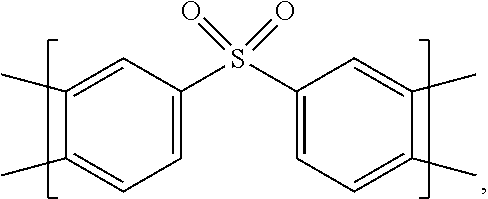





View All Diagrams
| United States Patent Application | 20190359852 |
| Kind Code | A1 |
| HO; MING-JAAN ; et al. | November 28, 2019 |
MODIFIED POLYIMIDE COMPOUND, RESIN COMPOSITION AND POLYIMIDE FILM
Abstract
A resin composition comprises a modified polyimide compound, an epoxy resin, and a solvent. The modified polyimide compound has a chemical structural formula of ##STR00001## the Ar' represents a group selected from a group consisting of phenyl having a chemical structural formula of ##STR00002## diphenyl ether having a chemical structural formula of ##STR00003## biphenyl having a chemical structural formula of ##STR00004## hexafluoro-2,2-diphenylpropane having a chemical structural formula of ##STR00005## benzophenone having a chemical structural formula of ##STR00006## and diphenyl sulfone having a chemical structural formula of ##STR00007## and any combination thereof, the modified polyimide compound has a degree of polymerization n of about 1 to about 50, the epoxy resin and the modified polyimide compound are in a molar ratio of about 0.1:1 to about 1:1. A modified polyimide compound and a polyimide film are also provided.
| Inventors: | HO; MING-JAAN; (Taoyuan, TW) ; HSU; MAO-FENG; (Taoyuan, TW) ; HSIANG; SHOU-JUI; (Taoyuan, TW) ; HUANG; NAN-KUN; (Taoyuan, TW) ; KAO; YU-WEN; (Taoyuan, TW) ; TENG; CHIA-YIN; (Taoyuan, TW) ; LIN; CHING-HSUAN; (Taoyuan, TW) | ||||||||||
| Applicant: |
|
||||||||||
|---|---|---|---|---|---|---|---|---|---|---|---|
| Family ID: | 62838747 | ||||||||||
| Appl. No.: | 16/533932 | ||||||||||
| Filed: | August 7, 2019 |
Related U.S. Patent Documents
| Application Number | Filing Date | Patent Number | ||
|---|---|---|---|---|
| 15689166 | Aug 29, 2017 | 10428238 | ||
| 16533932 | ||||
| Current U.S. Class: | 1/1 |
| Current CPC Class: | C08G 73/101 20130101; C08G 73/1039 20130101; C08G 73/1067 20130101; C08G 73/1064 20130101; C08G 73/1028 20130101; C09D 179/08 20130101; C08G 73/1071 20130101; C08L 2203/202 20130101; C09D 179/08 20130101; C08L 63/00 20130101; C08K 7/22 20130101; C08G 73/1053 20130101; C08G 73/1032 20130101; C08L 63/00 20130101 |
| International Class: | C09D 179/08 20060101 C09D179/08; C08G 73/10 20060101 C08G073/10; C08L 63/00 20060101 C08L063/00 |
Foreign Application Data
| Date | Code | Application Number |
|---|---|---|
| Jan 16, 2017 | TW | 106101438 |
Claims
1. A resin composition comprising: a modified polyimide compound; an epoxy resin; and a solvent; wherein the modified polyimide compound has a chemical structural formula of ##STR00033## the Ar' represents a group selected from a group consisting of phenyl having a chemical structural formula of ##STR00034## diphenyl ether having a chemical structural formula of ##STR00035## biphenyl having a chemical structural formula of ##STR00036## hexafluoro-2,2-diphenylpropane having a chemical structural formula of ##STR00037## benzophenone having a chemical structural formula of ##STR00038## and diphenyl sulfone having a chemical structural formula of ##STR00039## and any combination thereof, the modified polyimide compound has a degree of polymerization n of about 1 to about 50, the epoxy resin and the modified polyimide compound are in a molar ratio of about 0.1:1 to about 1:1.
2. The resin composition of claim 1, wherein the resin composition further comprises porous materials.
3. The resin composition of claim 3, wherein the modified polyimide compound and the porous materials are in a ratio of about 1000:1 to about 10:1 by weight.
4. The resin composition of claim 1, wherein the solvent is N,N-dimethylacetamide.
5. A polyimide film formed by heating a resin composition to undergo a polymerization reaction, wherein the resin composition comprises a modified polyimide compound, an epoxy resin, and a solvent, the modified polyimide compound and the epoxy resin are heated to undergo the polymerization reaction, the modified polyimide compound has a chemical structural formula of ##STR00040## the Ar' represents a group selected from a group consisting of phenyl having a chemical structural formula of ##STR00041## diphenyl ether having a chemical structural formula of ##STR00042## biphenyl having a chemical structural formula of ##STR00043## hexafluoro-2,2-diphenylpropane having a chemical structural formula of ##STR00044## benzophenone having a chemical structural formula of ##STR00045## and diphenyl sulfone having a chemical structural formula of ##STR00046## and any combination thereof, the modified polyimide compound has a degree of polymerization n of about 1 to about 50, the epoxy resin and the modified polyimide compound are in a molar ratio of about 0.1:1 to about 1:1.
6. The polyimide film of claim 10, wherein the resin composition further comprises porous materials.
7. The polyimide film of claim 11, wherein the modified polyimide compound and the porous materials are in a ratio of about 1000:1 to about 10:1 by weight.
8. The polyimide film of claim 11, wherein the solvent is N,N-dimethylacetamide.
9. A modified polyimide compound having a chemical structural formula of ##STR00047## wherein the Ar' represents a group selected from a group consisting of phenyl having a chemical structural formula of ##STR00048## diphenyl ether having a chemical structural formula of ##STR00049## biphenyl having a chemical structural formula of ##STR00050## hexafluoro-2,2-diphenylpropane having a chemical structural formula of ##STR00051## benzophenone having a chemical structural formula of ##STR00052## and diphenyl sulfone having a chemical structural formula of ##STR00053## and any combination thereof, the modified polyimide compound has a degree of polymerization n of about 1 to about 50.
Description
CROSS-REFERENCE TO RELATED APPLICATIONS
[0001] This is a divisional application of patent application Ser. No. 15/689,166, filed on, Aug. 29, 2017, assigned to the same assignee, which is based on and claims priority to Taiwan Patent Application No. 106101438 filed on Jan. 16, 2017, the contents of which are incorporated by reference herein.
FIELD
[0002] The subject matter herein generally relates to a modified polyimide compound, a resin composition, and a polyimide film.
BACKGROUND
[0003] Flexible circuit boards usually include polyimide films. Such polyimide film is formed by diamine compounds and anhydride compounds, and has a high dielectric constant D.sub.k (greater than 3.0). Thus, the flexible circuit board cannot provide an impedance match for high frequency signals to be transmitted thereto.
BRIEF DESCRIPTION OF THE DRAWINGS
[0004] Implementations of the present technology will now be described, by way of example only, with reference to the attached figures.
[0005] FIG. 1 is a flowchart of an exemplary embodiment of a method for manufacturing a polyimide film.
[0006] FIG. 2 is a diagram of an exemplary embodiment of a circuit board.
DETAILED DESCRIPTION
[0007] It will be appreciated that for simplicity and clarity of illustration, where appropriate, reference numerals have been repeated among the different figures to indicate corresponding or analogous elements. In addition, numerous specific details are set forth in order to provide a thorough understanding of the embodiments described herein. However, it will be understood by those of ordinary skill in the art that the embodiments described herein can be practiced without these specific details. In other instances, methods, procedures, and components have not been described in detail so as not to obscure the related relevant feature being described. Also, the description is not to be considered as limiting the scope of the embodiments described herein. The drawings are not necessarily to scale, and the proportions of certain parts may be exaggerated to better illustrate details and features of the present disclosure.
[0008] The term "comprising," when utilized, means "including, but not necessarily limited to"; it specifically indicates open-ended inclusion or membership in the so-described combination, group, series, and the like.
[0009] An exemplary embodiment of a resin composition comprises a modified polyimide compound, an epoxy resin, and a solvent. In at least one exemplary embodiment, the epoxy resin and the modified polyimide compound are in a molar ratio of about 0.1:1 to about 1:1.
[0010] The modified polyimide compound has a chemical structural formula of
##STR00008##
wherein Ar' represents a group selected from a group consisting of phenyl having a chemical structural formula of
##STR00009##
diphenyl ether having a chemical structural formula of
##STR00010##
biphenyl having a chemical structural formula of
##STR00011##
hexafluoro-2,2-diphenylpropane having a chemical structural formula of
##STR00012##
benzophenone having a chemical structural formula of
##STR00013##
and diphenyl sulfone having a chemical structural formula of
##STR00014##
and any combination thereof. In at least one exemplary embodiment, the modified polyimide compound has a degree of polymerization of about 1 to about 50.
[0011] In at least one exemplary embodiment, the modified polyimide compound is made by the following steps:
##STR00015## ##STR00016##
[0012] The epoxy resin has a chemical structure selected from a group consisting of
##STR00017##
and any combination thereof.
[0013] In at least one exemplary embodiment, the solvent is N,N-dimethylacetamide.
[0014] In at least one exemplary embodiment, the resin composition can further comprise of porous materials. In this exemplary embodiment, the porous materials are molecular sieves obtainable from Tianjin Nankai University Catalyst Plant under the trade name "MCM-41". The modified polyimide compound and the porous materials are in a ratio of about 1000:1 to about 10:1 by weight.
[0015] A method for preparing the resin composition may comprise the following steps: (1) adding the modified polyimide compound, the epoxy resin, and the solvent in a vessel; (2) stirring the modified polyimide compound, the epoxy resin, and the solvent until the modified polyimide compound and the epoxy resin dissolve in the solvent.
[0016] FIG. 1 illustrates a flowchart of a method for manufacturing a polyimide film 20 (shown in FIG. 2) using the resin composition in accordance with an exemplary embodiment. The exemplary method is provided by way of example, as there are a variety of ways to carry out the method. Each block shown in the figure represents one or more processes, methods, or subroutines, carried out in the exemplary method. Furthermore, the illustrated order of blocks is by example only, and the order of the blocks can change. Additional blocks may be added, or fewer blocks may be utilized, without departing from this disclosure. The exemplary method can begin at block 11.
[0017] At block 11, the resin composition is coated on a surface of a base, and is heated to cause the modified polyimide compound and the epoxy resin to undergo a polymerization reaction. In at least one exemplary embodiment, the resin composition is placed in a furnace and heated through four heating processes. The first heating process is heating the resin composition from 25 degrees Celsius to 140 degrees Celsius and maintaining the heating of the resin composition at 140 degrees Celsius for 30 min. The second heating process is heating the resin composition from 140 degrees Celsius to 180 degrees Celsius and maintaining the heating of the resin composition at 180 degrees Celsius for 2 hours. The third heating process is heating the resin composition from 180 degrees Celsius to 200 degrees Celsius and maintaining the heating of the resin composition at 200 degrees Celsius for 2 hours. The fourth heating process is heating the resin composition from 200 degrees Celsius to 220 degrees Celsius and maintaining the heating of the resin composition at 220 degrees Celsius for 2 hours.
[0018] At block 12, after the polymerization reaction, the resin composition is dried and separated from the base, thereby forming the polyimide film 20.
[0019] FIG. 2 illustrates an exemplary embodiment of a circuit board 100 comprising at least one circuit substrate 30 and a polyimide film 20 formed on at least one surface of each circuit substrate 30. The polyimide film 20 is formed by heating the resin composition, to cause the modified polyimide compound and the epoxy resin of the resin composition to undergo a polymerization reaction.
[0020] In the resin composition, the modified polyimide compound comprises acrylate groups at side chains. When the resin composition is heated to form the polyimide film 20, the acrylate groups at side chains of the modified polyimide compound and the epoxy resin react with each other, to reduce a dielectric constant D.sub.k of the polyimide film 20. Furthermore, the resin composition can form a cross-linking structure when the resin composition is heated to form the polyimide film 20, which can increase the cross-linking density of the polyimide film 20, so that heat resistance of the polyimide film 20 is improved for soldering. Thus, the polyimide film 20 can have an improved thermal resistance. Moreover, because the modified polyimide compound comprises of 9,10-dihydro-9-oxa-10-phosphaphenanthrene-10-oxide groups, the polyimide film 20 has a preferred flame retardancy. In addition, when the resin composition is comprised of porous materials, air can penetrate the porous materials of the polyimide film 20 to further decrease the dielectric constant D.sub.k.
EXAMPLE 1
[0021] 4.8 g of 9,10-dihydro-9-oxa-10-phosphaphenanthrene-10-oxide (DOPO), 3.0 g of 4-aminoacetophenone of, 4.8 g of 2-aminophenol, 0.19 g of 4-methylbenzenesulfonic acid (P-TSA), and 10.0 g of dimethyl sulfoxide were added into a first container and stirred. The first container was heated at 100 degrees Celsius for 12 hours under a nitrogen atmosphere to form a first product having a chemical structural formula of
##STR00018##
[0022] 1.0 g of the first product, 0.7 g of 1,2,4,5-benzenetetracarboxylic anhydride, 6.8 g 1-methyl-2-pyrrolidinone (NMP), and 3.4 g xylene were added into a second container and stirred. The second container was heated at 140 degrees Celsius for 20 hours under a nitrogen atmosphere to initiate a reflux reaction to form a second product having a chemical structural formula of
##STR00019##
[0023] 10.0 g of the second product, 3.5 g of methacrylic anhydride, 0.1 g of sodium acetate, and 100.0 g of N,N-dimethylacetamide (DMAC)were added a third container and stirred. The third container was heated at 80 degrees Celsius for 12 hours under a nitrogen atmosphere to initiate a reflux reaction to form a modified polyimide compound (I) having a chemical structural formula of
##STR00020##
[0024] 100.0 g of the modified polyimide compound (I), an epoxy resin having a chemical structural formula of
##STR00021##
and 100.0 g of N,N-dimethylacetamide were added into a fourth container and stirred to form the resin composition. The epoxy resin and the modified polyimide compound (I) were in a molar ratio of 1:1. The resin composition had a viscosity of about 50000 cps.
EXAMPLE 2
[0025] Modified polyimide compound (II) having a chemical structural formula of
##STR00022##
was formed. Different from the example 1, 0.7 g of the 1,2,4,5-benzenetetracarboxylic anhydride was replaced by 0.7 g of 4,4'-oxydiphthalic anhydride.
[0026] 100.0 g of the modified polyimide compound (II), an epoxy resin having a chemical structural formula of
##STR00023##
and 100.0 g of N,N-dimethylacetamide were added into a container and stirred to form the resin composition. The epoxy resin and the modified polyimide compound (II) were in a molar ratio of 1:1. The resin composition had a viscosity of about 40000 cps.
EXAMPLE 3
[0027] Modified polyimide compound (III) having a chemical structural formula of
##STR00024##
was formed. Different from the example 1, 0.7 g of the 1,2,4,5-benzenetetracarboxylic anhydride was replaced by 0.7 g of 3,4,3',4'-biphenyltetracarboxylic dianhydride.
[0028] 100.0 g of the modified polyimide compound (III), an epoxy resin having a chemical structural formula of
##STR00025##
and 100.0 g of N,N-dimethylacetamide were added into a container and stirred to form the resin composition. The epoxy resin and the modified polyimide compound (III) were in a molar ratio of 1:1. The resin composition had a viscosity of about 48000 cps.
EXAMPLE 4
[0029] Modified polyimide compound (IV) having a chemical structural formula of
##STR00026##
was formed. Different from the example 1, 0.7 g of the 1,2,4,5-benzenetetracarboxylic anhydride was replaced by 0.7 g of 4,4'-(hexafluoroisopropylidene)diphthalic anhydride.
[0030] 100.0 g of the modified polyimide compound (IV), an epoxy resin having a chemical structural formula of
##STR00027##
and 100.0 g of N,N-dimethylacetamide were added into a container and stirred to form the resin composition. The epoxy resin and the modified polyimide compound (IV) were in a molar ratio of 1:1. The resin composition had a viscosity of about 23000 cps.
EXAMPLE 5
[0031] Modified polyimide compound (V) having a chemical structural formula of
##STR00028##
was formed. Different from the example 1, 0.7 g of the 1,2,4,5-benzenetetracarboxylic anhydride was replaced by 0.7 g of 3,3',4,4'-benzophenonetetracarboxylic dianhydride.
[0032] 100.0 g of the modified polyimide compound (V), an epoxy resin having a chemical structural formula of
##STR00029##
and 100.0 g of N,N-dimethylacetamide were added into a container and stirred to form the resin composition. The epoxy resin and the modified polyimide compound (V) were in a molar ratio of 1:1. The resin composition had a viscosity of about 50000 cps.
EXAMPLE 6
[0033] Modified polyimide compound (VI) having a chemical structural formula of
##STR00030##
was formed. Different from the example 1, 0.7 g of the 1,2,4,5-benzenetetracarboxylic anhydride was replaced by 0.7 g of 3,3',4,4'-diphenyl sulfonetetracarboxylic anhydride.
[0034] 100.0 g of the modified polyimide compound (VI), an epoxy resin having a chemical structural formula of
##STR00031##
and 100.0 g of N,N-dimethylacetamide were added into a container and stirred to form the resin composition. The epoxy resin and the modified polyimide compound (VI) were in a molar ratio of 1:1. The resin composition had a viscosity of about 40000 cps.
EXAMPLE 7
[0035] 100.0 g of the modified polyimide compound (III) of example 3, 0.5 g of molecular sieves (Manufacturer: Tianjin Nankai University Catalyst Plant, Model: "MCM-41"), and an epoxy resin having a chemical structural formula of
##STR00032##
and 100.0 g of N,N-dimethylacetamide were added into a container and stirred to form the resin composition. The epoxy resin and the modified polyimide compound (III) were in a molar ratio of 1:1. The resin composition had a viscosity of about 48000 cps.
COMPARATIVE EXAMPLE 1
[0036] 70 g of 1,4-benzenediamine, 30 g of 3,4,3',4'-biphenyltetracarboxylic dianhydride, and 100 g of N,N-dimethylacetamide were added into a container and stirred to form a resin composition. The resin composition had a viscosity of about 40000 cps.
COMPARATIVE EXAMPLE 2
[0037] 70 g of 1,4-benzenediamine, 30 g of a modified 3,4,3',4'-biphenyltetracarboxylic dianhydride which was modified by methacrylic anhydride, and 100 g of N,N-dimethylacetamide were added into a container and stirred to form a resin composition. The resin composition had a viscosity of about 20561 cps.
COMPARATIVE EXAMPLE 3
[0038] 70 g of 1,4-benzenediamine, 30 g of 3,4,3',4'-biphenyltetracarboxylic dianhydride, 0.5 g of molecular sieves (Manufacturer: Tianjin Nankai University Catalyst Plant, Model: "MCM-41"), and 100 g of N,N-dimethylacetamide were added into a container and stirred to form a resin composition. The resin composition had a viscosity of about 25656 cps.
[0039] Seven first test samples were made. Each of the seven first test samples comprises a copper foil and a polyimide film made by heating the resin compositions of the examples 1, 2, 3, 4, 5, 6, and 7, respectively, through four heating processes. The first heating process is heating the resin composition from 25 degrees Celsius to 140 degrees Celsius and maintaining the heating of the resin composition at 140 degrees Celsius for 30 min. The second heating process is heating the resin composition from 140 degrees Celsius to 180 degrees Celsius and maintaining the heating of the resin composition at 180 degrees Celsius for 2 hours. The third heating process is heating the resin composition from 180 degrees Celsius to 200 degrees Celsius and maintaining the heating of the resin composition at 200 degrees Celsius for 2 hours. The fourth heating process is heating the resin composition from 200 degrees Celsius to 220 degrees Celsius and maintaining the heating of the resin composition at 220 degrees Celsius for 2 hours.
[0040] Three second test samples were made. Each of the three second test samples comprises a copper foil and a polyimide film made by heating the resin compositions of the comparative examples 1, 2, and 3, respectively, through two heating processes. The first heating process is heating the resin composition from 25 degrees Celsius to 140 degrees Celsius and maintaining the heating of the resin composition at 140 degrees Celsius for 30 min. The second heating process is heating the resin composition from 140 degrees Celsius to 350 degrees Celsius and maintaining the heating of the resin composition at 350 degrees Celsius for 1 hours.
[0041] Dielectric constant D.sub.k, and dielectric dissipation factor D.sub.f of each of the polyimide films formed by the resin compositions of examples 1 to 7 and the resin compositions of the comparative examples 1 to 3 were tested. Thermal resistance, and copper peeling strength of the seven first test samples and the three second test samples were tested. The test results were shown in the following Table 1. The thermal resistance was tested at a temperature of 288 degrees centigrade for 10 seconds, if the polyimide film did not blister and peel off, the result of the thermal resistance test is considered passing, otherwise, the result fails.
TABLE-US-00001 TABLE 1 Product Example Example Example Example Example Example Example Comparative Compamtive Comparative Property 1 2 3 4 5 6 7 example 1 example 2 example 3 D.sub.k (10 GHz) 2.75 2.90 2.83 2.55 2.82 2.95 2.90 3.20 3.10 3.00 D.sub.f (10 GHz) 0.008 0.009 0.006 0.006 0.008 0.009 0.006 0.006 0.011 0.005 Results of the Pass Pass Pass Pass Pass Pass Pass Pass Pass Pass thermal resistance test Copper peeling 0.96 0.93 0.97 0.96 0.96 0.93 0.97 1.02 1.04 0.98 strength (kgf/cm)
[0042] According to the Table 1, the dielectric constant of the polyimide films formed by the resin compositions of examples 1, 2, 3, 4, 5, 6, and 7 are lower than the polyimide films formed by the resin compositions of the comparative examples 1, 2, and 3. In addition, the polyimide films made by the resin compositions of the examples 1, 2, 3, 4, 5, 6, and 7 have a preferred thermal resistance, respectively.
[0043] It is to be understood, even though information and advantages of the present embodiments have been set forth in the foregoing description, together with details of the structures and functions of the present embodiments, the disclosure is illustrative only; changes may be made in detail, especially in matters of shape, size, and arrangement of parts within the principles of the present embodiments to the full extent indicated by the plain meaning of the terms in which the appended claims are expressed.
* * * * *

























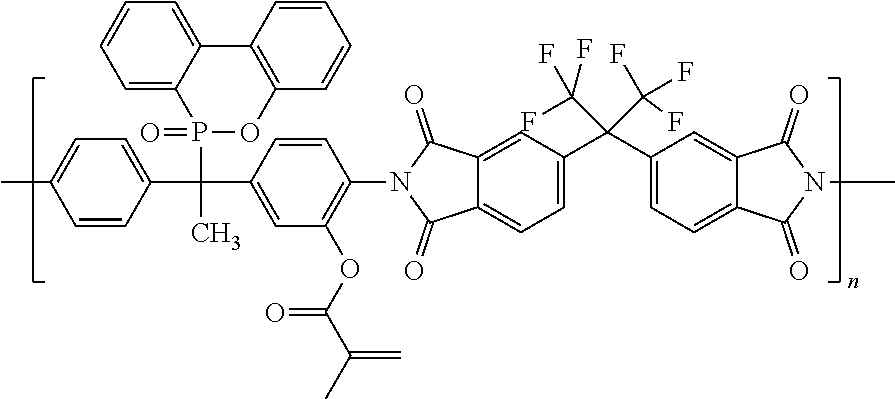


















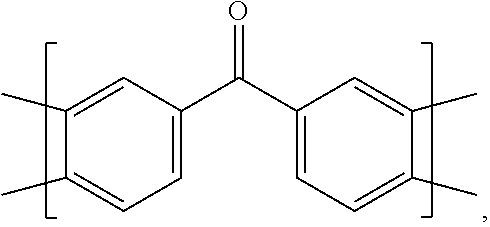








D00000
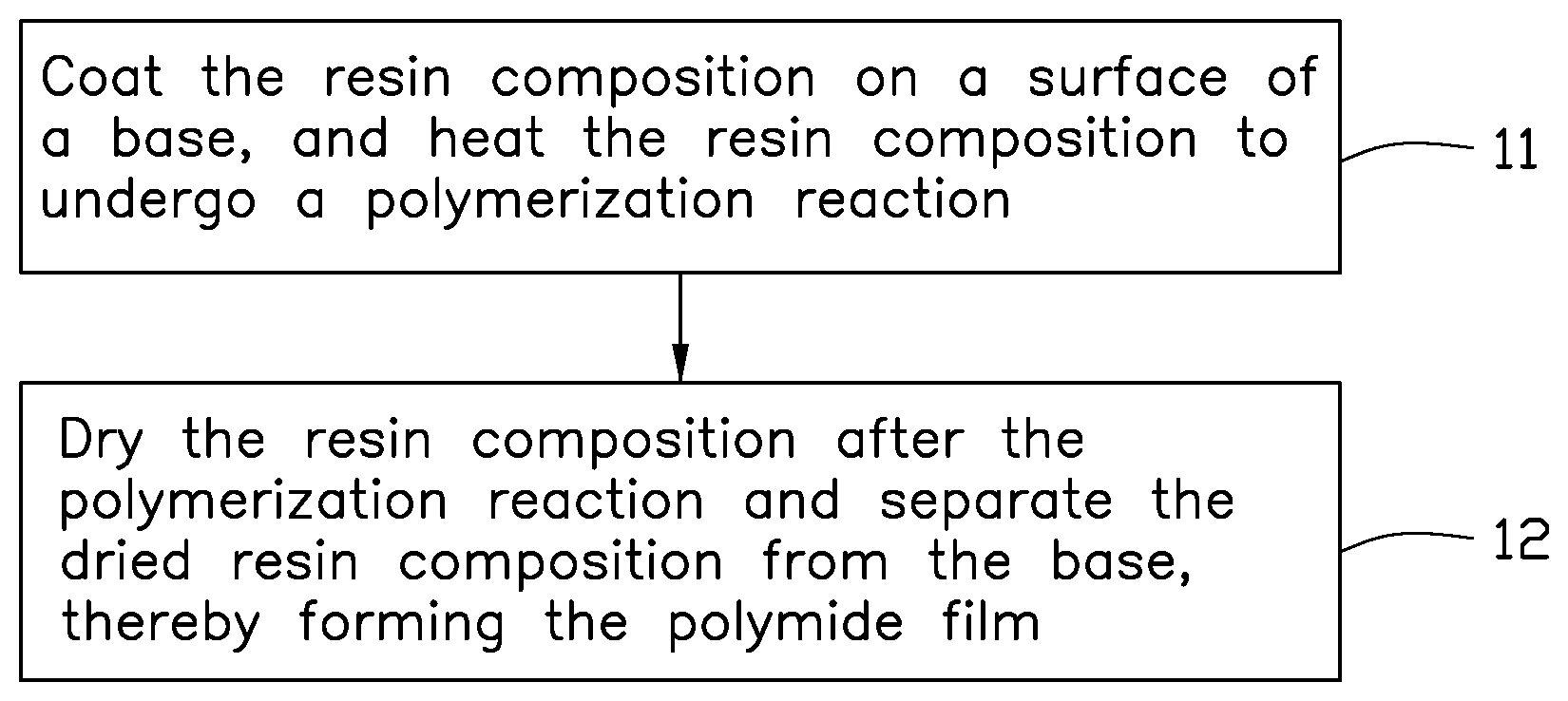
D00001
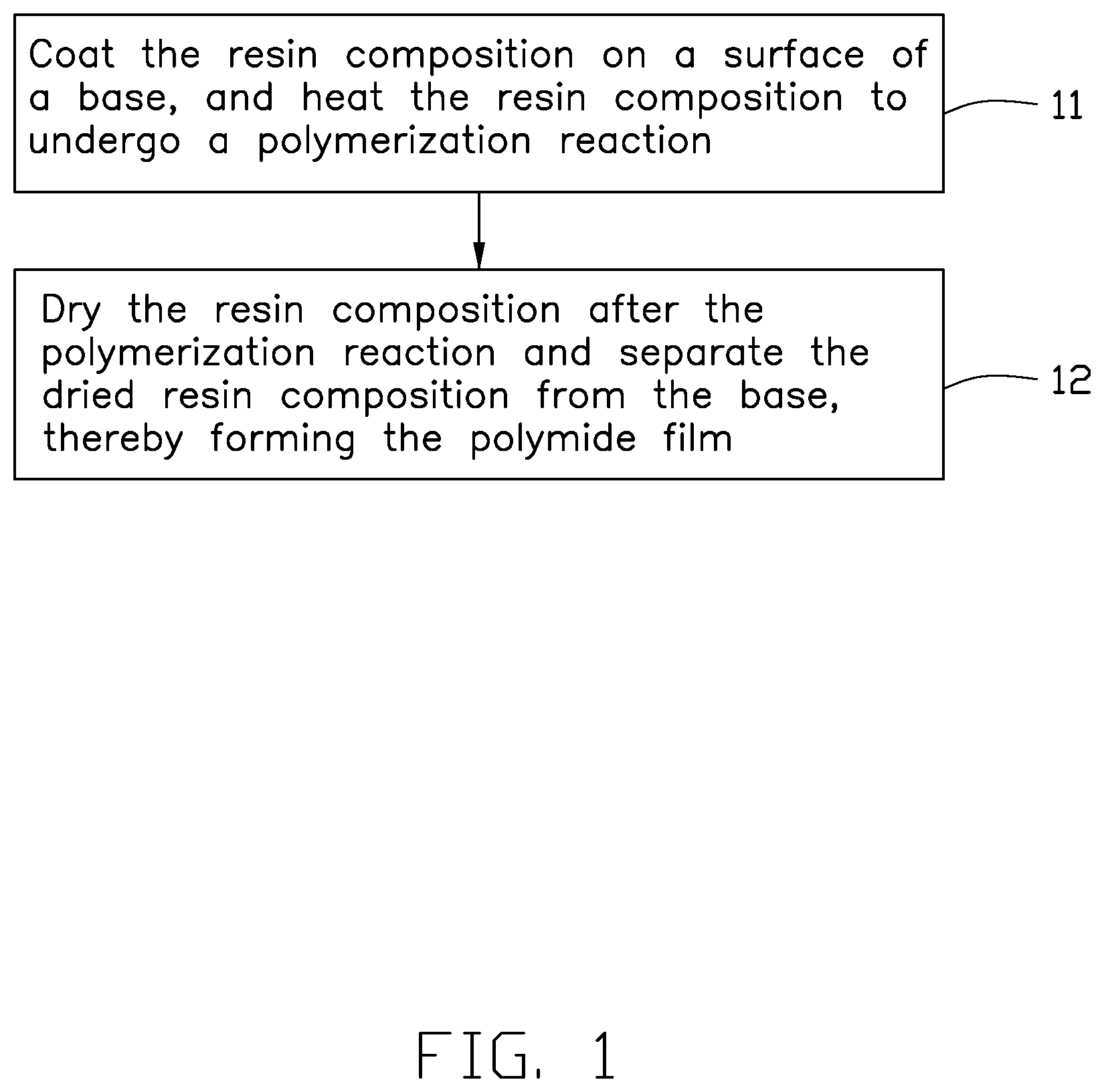
D00002

XML
uspto.report is an independent third-party trademark research tool that is not affiliated, endorsed, or sponsored by the United States Patent and Trademark Office (USPTO) or any other governmental organization. The information provided by uspto.report is based on publicly available data at the time of writing and is intended for informational purposes only.
While we strive to provide accurate and up-to-date information, we do not guarantee the accuracy, completeness, reliability, or suitability of the information displayed on this site. The use of this site is at your own risk. Any reliance you place on such information is therefore strictly at your own risk.
All official trademark data, including owner information, should be verified by visiting the official USPTO website at www.uspto.gov. This site is not intended to replace professional legal advice and should not be used as a substitute for consulting with a legal professional who is knowledgeable about trademark law.